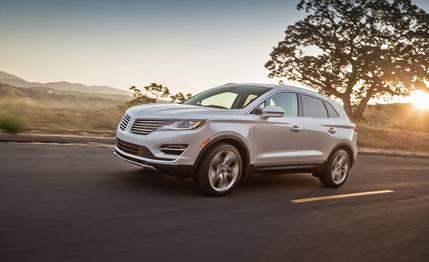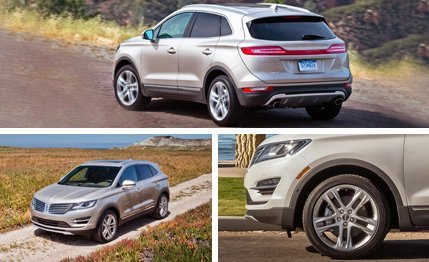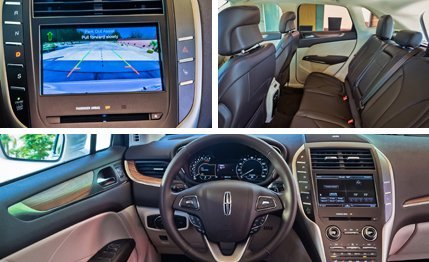
 First Drive Review
First Drive Review
Let’s state one inescapable truth right now: The Lincoln MKC is based on the Ford Escape. But this Pygmalion strategy is neither unique nor scandalous: Other luxury marques disguise mass-market products beneath thin veneers of extravagance. Think Acura RDX/Honda CR-V or Porsche Cayenne/Volkswagen Touareg.
The key is that most brands are adept at differentiating the pricier product, but Lincoln hasn’t successfully hidden the Ford in its vehicles for a long time. This new MKC crossover, however, gives us hope that its maker is starting to build better Lincolns rather than just better Fords.
The MKC is arguably the best execution of Lincoln’s current design language, with a less-ostentatious grille than the wings-of-Icarus melted to the front of the MKZ sedan. The overall aesthetic is vaguely European when viewed from the rear and in profile, with much of the Old World flavor derived from aping Audi Q5 cues. Like the Q5, the MKC utilizes a clamshell liftgate that incorporates the taillights, and the greenhouse traces the same line as the Audi’s. But the design details, the brightwork, and the sheetmetal creasing are enough to differentiate this Lincoln from its competition and, perhaps more important, the Ford Escape.
If only Lincoln had borrowed a few Audi interior design ideas. Instead, Lincoln stitched up a vinyl-wrapped interior that reminds us of the MKZ’s. Even the MKZ’s pushbutton transmission controls have carried over into the MKC. Even thought they are not aesthetically elegant, the buttons mean the space normally allotted to a console-mounted shift knob has been given over to a small storage cubby and a couple of cup holders.


Unlike in the MKZ, actual buttons and knobs control the climate-control and audio systems. Whereas this is a step forward, the seat bottoms aren’t particularly supportive, and the Bridge of Weir leather isn’t especially special. The interior might not scream Ford, but it still screams MKZ, which barely whimpers luxury.
If the definition of luxury includes space as well as materials, the rear seat of the MKC also misses the mark. Riding on the same 105.9-inch wheelbase as the Escape, the MKC would benefit from at least a three-inch wheelbase stretch to enhance rear-seat comfort and legroom.
Two EcoBoost engines are available, with the entry powerplant being a 240-hp, 2.0-liter turbocharged four-cylinder that is shared with the Escape. We drove the new 2.3-liter turbo four that will also see duty in the Mustang; it makes 285 horsepower and 305 lb-ft of torque in the MKC. The engine sounds subdued at idle and at speed, although a trace of intake grittiness enters the cabin if you listen carefully. Even with the 2.3-liter, this probably won’t be the quickest vehicle in its segment. We have yet to perform instrumented testing, but the engine doesn’t sweep toward the redline with the intensity you might expect, given its nearly 300-horsepower rating. A 0-to-60-mph time of just below seven seconds seems about right.
A shorter final-drive ratio compared with the Escape’s helps initial acceleration, but it is likely simultaneously responsible for dinging fuel economy slightly compared with the Ford’s. With the 2.0-liter, the MKC manages 20 mpg in the city and 29 on the highway; opting for four-wheel drive reduces those numbers to 19 and 26. Moving up to the 2.3-liter engine brings standard four-wheel drive and EPA numbers of 18 mpg city and 26 highway.
Another unimpressive number is the nearly 4000-pound curb weight for the 2.3-liter version. Despite its heft, the MKC remains stable and flat in corners, and the steering is responsive without exhibiting any nervousness. Three-position, electronically controlled shocks are standard on four-wheel-drive versions and a $650 option on front-drivers. Current or former Town Car owners will feel right at home in Comfort mode. Switch to Sport, and the MKC’s ride becomes too jittery. It’s best to leave the shocks in Normal, which nicely balances ride comfort with the right amount of body control.


Pricing begins about where the Escape’s leaves off. In its most basic guise (Premiere), the MKC costs $33,995. Adding four-wheel drive to a 2.0-liter requires another $2495. The more powerful 2.3-liter version with standard all-wheel drive opens at $37,630, or $1140 more than a comparable 2.0-liter version. Stick to the well-equipped Premiere trim rather than jumping to the Select or Reserve, and the MKC strikes us as a compelling buy below $40,000.
Should you move up a rung, the Select trim adds leather seats, a leather-wrapped steering wheel, ambient lighting, an auto-dimming driver’s side mirror, daytime running lamps, different 18-inch wheels—and $3230 to the bottom line. The Select unlocks the option of navigation, although you have to spec an $1100 bundle that includes blind-spot monitoring to get it. At the top of the lineup sits the Reserve, which asks $3705 above the Select and brings along a giant sunroof, navigation, a power tilting-and-telescoping steering wheel, an automatic liftgate, and blind-spot monitoring. There is a range of stand-alone options and bundles you can order to avail yourself of things like a heated steering wheel, rain-sensing wipers, 19- or 20-inch wheels, and an upgraded audio. Fully loaded, it’s possible to surpass $50,000.
But even at a price $10,000 lower, the MKC faces stiff competition from established players like the Q5, BMW X3, and Mercedes-Benz GLK-class, which share major components with legitimate sports sedans, not a $23,000 Ford. Buyers sniffing above $40,000 can consider larger alternatives like the Cadillac SRX, Lexus RX350, and Volvo XC60. But the MKC, when kept below $40,000, looks and acts polished enough to wear its luxury badge, which is more than we’ve been able to say about a Lincoln for some time.